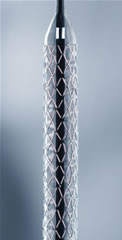 |

|
 |
Dr. David E. Kandzari
is Director of Interventional Cardiology
Research at
Scripps Clinic in La Jolla, California. His career in interventional cardiology
has been unique in that he has had the opportunity to be involved
in drug-eluting stent issues from multiple perspectives.
At Duke Clinical Research
Institute
he was the John B. Simpson Assistant Professor of interventional
cardiology and
genomic
sciences
and an assistant
professor of medicine and molecular genetics and microbiology.
In
2006, a year which saw a number of high profile cardiologists
leave their academic or clinical positions for industry,
Kandzari left Duke to become chief medical officer for Johnson
& Johnson's
Cordis Cardiology Division. As such, Kandzari joined the medical
device manufacturer during its most
trying period during the FDA specially-convened
panel on DES safety. Previously Dr. Kandzari had also been
co-principal investigator for Medtronic's Endeavor III and
IV clinical
trials. He left Cordis in May 2008 for his current position
at Scripps, but in-between served three months as
a medical officer in the FDA's
Center
for
Devices
and Radiological
Health. |
|

David E.
Kandzari, MD |
Q: A study from Duke, your
former institution, was published in Circulation:
Cardiovascular Quality and Outcomes last
month. It chronicled the major effect
that the mainstream press and professional
journals
had on
the precipitous drop in usage of drug-eluting
stents back in 2006 -- from a peak of 90% down to 58%. Was this
information surprising?
Dr. Kandzari: I think that the article by Roe and colleagues from
the CRUSADE Registry is important and it's an academic
approach to documenting what we observed as clinicians. But in
many ways, it's certainly
not new news: the financial analyst community
documented those metrics in much broader global populations much
earlier and
in much
more detail than even the Duke investigators have done. We've been
going around for two-and-a-half years now showing slides of the
metrics of DES utilization that has been tracked on a monthly basis.
So I
think the industry and analyst community have tracked this very
very closely and have shared this with the clinical community well
before
this time. Again it's not to discount the importance of the work,
but this is something that we've observed in real live practice
now for almost three years since the so-termed "firestorm" of
the European Society of Cardiology.
Q: Where is DES usage today
and has the worry about safety subsided?
Dr. Kandzari: We now have observed that the
utilization of drug-eluting stents in the United States has increased
to account for about 75-76% of all PCI procedures. And I think
it's likely that, at least in the current environment, this
number, this 75-80% DES utilization on average will be
close to approximating equilibrium, pending resolution of outstanding
issues of stent safety -- including what the optimal duration
of dual
antiplatelet
therapy is, and also with the introduction of advanced generation
drug-eluting stents that might be perceived safer.
I think that most clinicians, even well beyond
the interventional community, feel reassured of the overall benefits
of drug-eluting
stent use in appropriately selected patients. The most recent and
probably final large meta-analysis (265,000 patients) of drug-eluting
and bare metal stents was taken from the ACC-NCDR Registry by Pam
Douglas and published
in JACC. The study not only reaffirms
the safety and
relative benefit of drug-eluting
stents compared with bare metal stents, but in my view it also
really highlights that evidence-based medicine is still very much
alive
and well in the practice of interventional cardiology. What I mean
to say by that is studies show that in a non-randomized fashion
in real-world practice, when clinicians have available to them
both products, bare metal and drug-eluting stents, and they have
the
opportunity to make decisions and selections regarding who should
and who should not receive drug-eluting stents, that this seems
to overall translate into benefits for the patients and with continued
safety as well.
Q: You mentioned that there are still
pending safety issues with DES?
Dr. Kandzari: To me the outstanding
issues right now with regard to drug-eluting stents, if you think
about
areas of equipoise,
one still would be "what is the optimal duration of dual antiplatelet
therapy?" The other would the use of drug-eluting stents in
acute coronary syndrome patients and especially patients with ST
Elevation Myocardial Infarction (STEMI). And then I think there
are lesser indications in which there's still some uncertainty
about
the relative
benefit, for example, the treatment of saphenous vein graft disease,
or large caliper vessels in which the restenosis benefit may not
be as prominent as in other patient complexities.
I think the greatest barrier at present to the
use of drug-eluting stents is the lack of understanding about dual
antiplatelet therapy.
We have a societal guidelines recommendation that by consensus
opinion and less based on evidence of dual antiplatelet therapy.
And yet there are many clinicians who feel that that is not warranted,
that longer-term dual antiplatelet therapy may not reduce the risk
of late stent thrombosis. This is offset by other clinicians
who feel that the use of a drug-eluting stent means a lifetime
commitment to dual antiplatelet therapy. There are a number
of studies that are under development or underway to help identify
what the so-termed optimal duration of dual antiplatelet therapy
is, but it's important to realize that the variation across these
studies is so wide too, that there's likely no singular trial that
will exclusively dictate our clinical practice with regards to
DAPT, but rather all of these trials will be considered an aggregate
to help inform our decision-making.

Medtronic's
2nd
generation Endeavor
drug-eluting stent |
|
Q: And there may be other
factors that may be discovered, such as patient genetic markers,
differences in drug-eluting stents, etc.
Dr. Kandzari: That's
exactly right. It's not even so simplistic to say, "Is 12 months
better than 6 months?" or "Is 30 months better than 12 months?" but
instead ask, "Is the so-termed optimal duration of DAPT the
same for all types of drug-eluting stents?", as we realize
that there are emerging differences in outcomes like stent
thrombosis among different drug-eluting stents.
What is the
optimal antiplatelet therapy regimen, given that there
are newer agents like Prasugrel available? Also we realize
that
there are important differences among individuals in
their responsiveness to antiplatelet therapy as well. So
there
are so many emerging complexities that it's no longer
such a simple
issue as comparing two different timelines of antiplatelet
treatment. Q: What do you think are the next big breakthroughs
in stenting?
Dr. Kandzari: I think, specific to stenting
alone, there are really two parallel emerging breakthroughs.
The first is the evolution of the drug-eluting stent to
stents with bioresorbable polymers, non-polymeric stents
and ultimately
a bioresorbable stent. I think we're still quite some time
away from seeing a bioresorbable stent as part of our routine
therapies. |
But on the other hand,
I think what is very tangible for us are stents in which there's
either no polymer or the polymer fulfills its obligation of delivering
the drug and then fades away and takes us back to a bare metal
stent. And there are early experiences with the bioresorbable polymers
that would suggest great efficacy but theoretically a safety advantage
given that a number of recent studies, including one
just published on aneurysm formation and stent thrombosis, have implicated at
least certain polymers with selected drug-eluting stents as being
associated
with hypersensitivity.
Then I think in parallel with this,
the second issue relates to these ongoing studies of antiplatelet
therapy.
If there's a third area about drug-eluting stents,
that would be expanding, with the benefits of DES that we’ve
realized, expanding DES into complex disease that historically
has been considered
the domain of cardiac surgery. We've certainly seen the relative
benefits and failures of drug-eluting stents compared with surgery
in the SYNTAX Trial; what is now in planning at least, and hopeful
to be
performed,
is a randomized trial comparing the use of DES in unprotected left
main disease with bypass surgery. In fact I was just at a planning
meeting for that this weekend in New York.
Q: We'll certainly look forward to that and other
studies that are coming out soon. Thank you for you time.
This interview was conducted in August 2009
by Burt Cohen of Angioplasty.Org.
|


